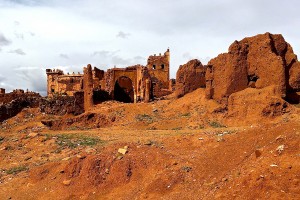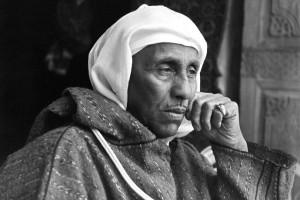Vanity Fair
BY Tom Freston
Revisiting Marrakech’s fascinating history of beheadings, prostitution, and a forgotten eccentric leader.
Marrakech, like Timbuktu or Kathmandu, is a city whose name conjures the faraway and exotic. These are otherworldly places that we know little about. When you go to Marrakech, in Morocco, you get a great sense of its long history as a gateway to the Sahara. Its recent history is harder to get a handle on. Stroll along a section of the Rue Dar el Glaoui, deep in city’s medina, and you’ll come across a long wall, tall and wide.
Maybe you can spot the tops of a few trees on the other side, but that’s about it. The place behind the wall is off-limits to tourists. It’s a place, to paraphrase Bob Dylan, that the city fathers are trying not to endorse. Had you walked by as recently as 1953, you might have encountered rows of salted and severed heads set on spikes in front of what was then a palace, Dar el Glaoui.
Today it’s the nondescript local of the U.M.T., Morocco’s labor union. But until Moroccan independence, in 1956, this was the palace of the Pasha of Marrakech, el Hadj T’hami El Glaoui, a Berber and one of the notorious Lords of the Atlas, thought then to perhaps be the richest man in the world. Once a mountain warlord who controlled the highly profitable desert trade routes, El Glaoui and his brother were installed by the French to rule Marrakech and Central Morocco in 1912. El Glaoui was a collaborator supreme—a man who backed the wrong horse and who now lies in the dustbin of Moroccan history. His story, though, is one of astonishing adventure. It’s all chronicled in Gavin Maxwell’s classic Lords of the Atlas. I have sent this book to many a Moroccan-bound traveler, always to appreciative response.
I flashed on all this late last year when heading out to Marrakech on business. All the recent beheadings in the news brought me back to El Glaoui. Much like our allies, the Saudis, who chop off heads in town squares, as well as their ideological offshoot, ISIS, who have decorated Paradise Square, in Raqqa, Syria, with rows of severed heads, El Glaoui saw cruelty and terror as what Harvard Business School might call “best practices.” He had no problem putting some heads outside the front door, or filling his dungeons with nationalists and other enemies. He was not an Islamist—more of an old-line mobster, but also a bon vivant and a ruler who oversaw many civic projects that continue to benefit the gorgeous city of Marrakech.
In 1969, just 13 years after El Glaoui died and Morocco became independent, Crosby, Stills & Nash released “Marrakesh Express,” which put Marrakech on the map for an entire generation. That set in motion a long caravan of VW buses jammed with hippies and other visitors. The last thing they were looking for was traces of El Glaoui or any deep dive into the real Morocco. I know; I was there myself. It was a far cry from the deluxe-resort vibe you find today. Marrakech was very foreign, a bit of a backwater, and brimming with cheap hotels and restaurants, along with the many pastry shops catering to hashish smokers. For a young foreigner, it seemed like a wild scene, but it was nothing compared to the Marrakech of the 20s and 30s, El Glaoui’s heyday. Those were the days of the French protectorate, and Paris had given control of Marrakech and the rest of Central Morocco to El Glaoui and his associates.
Putting them in charge was like letting the Mafia run Las Vegas. El Glaoui built a series of fortresses, or casbahs, to control the mountain passes, along with several extravagant palaces in the city itself, importing Italian artisans and sparing no expense. In Marrakech the French helped to lay out a whole new European-style city, Gueliz, that sat alongside the ancient medina, with broad jacaranda-lined boulevards, cafés, beautiful gardens, and Art Deco villas. There was a new railway link to Casablanca, with a beautiful train station. The iconic La Mamounia hotel opened its doors in 1923 (and was renovated in 2009 with extraordinary flair). El Glaoui even built Morocco’s first golf course. All of this provided a respectable level of elegance, making Marrakech a retreat for artists and the well heeled. Josephine Baker, Edith Piaf, Charlie Chaplin, Edward G. Robinson, even Winston Churchill made their way to exotic Marrakech. His Majesty, the Pasha, was a man of many contradictions, with a 150-woman harem and legions of slaves, as well as a love of Western cinema and American jazz. He spared no expense on entertainment for his visitors: fine wine, hashish, opium, jewelry, and Berber girls (and boys).
The Pasha made a fortune with olives, almonds, and saffron. But his big business was vice: sex, and drugs, something inextricably linked to the history of pre-independence Morocco. The lure of cheap living and the idea that there, in the warm sun, you could have copious amounts of whatever kinds of sex and drugs you desired, and whenever you wanted, proved irresistible to many.
El Glaoui had a lock on the immense prostitution business, from which he extracted huge revenues. Prostitution is illegal in Morocco now, but at the time of independence Marrakech was said to have had as many as 27,000 registered prostitutes, about 10 percent of the population. That is a lot of people to keep busy. The French had basically industrialized the prostitution business, as they did in many of their colonies, seeing colonial prostitution as a “necessary evil.” In place after place they established a highly organized series of red-light districts (the Quartier Reserve). At the top of the heap was a brothel stocked entirely with Europeans. To finance all this, private money was raised from French banks. At one point, the French resident-general had to ask the French Parliament for approval on a loan of 50 million francs ($2 million dollars at the time) to reimburse El Glaoui for money he had advanced to fund yet another new red-light district for 6,000 prostitutes. All of this was shut down at independence.
In his glory days, El Glaoui was the toast of London and Paris, a fascinating potentate who seemed to live even larger than the Indian princes. He traveled with a huge retinue and a portion of his harem. He hosted celebrities at lavish banquets in his palaces. The dank recesses downstairs were for his enemies. He never got what he wanted most—a British knighthood. He expected the sword on his shoulder at the 1953 coronation of Queen Elizabeth II, having lobbied for an invitation through his pal Winston Churchill. He was turned away and humiliated.
Later that same year he conspired with the French to dethrone Sultan Mohammed V, who had the support of Moroccan nationalists. Bad move. The French betrayed him and restored the sultan two years later as they headed for the exits. With independence, in 1956, the sultan became king. El Glaoui knelt before him and was granted forgiveness, but his power was gone. When he died, shortly thereafter, he was reviled as a traitor to his people. Angry mobs broke into his palace in Marrakech, chased down his henchmen, dragged them through the streets, poured gasoline on the unlucky, and burned them alive. All his property was confiscated by the state.
Looking now for a trace of El Glaoui, I organized a car to take me to the Kasbah Telouet, his castle in the High Atlas Mountains. We breezed by groves of olive trees and date palms in lush farmland, the windows open, then turned up into the reddish hills and climbed the switchbacks up into the cooler mountain air. It was all brown and gray granite above the tree line, with snow-capped peaks in the distance. After a few hours, near the top of the pass, we turned left onto a single-lane road that zigzagged into a narrow valley. It was neatly terraced, dry as a bone, and eerily quiet. We were 6,000 feet up, and surrounded by peaks twice as high. The ancient caravan routes from Timbuktu ran right through here. The Kasbah Telouet sat atop a hill straight ahead, dominating everything, in a state of appalling deterioration. Parts of it were already dust, piled up like snowbanks at the foot of the crumbling walls. The entrance doors, where many a head had been hung, were 20 feet high. I thought of Dracula. Since 1956 it had been sitting there pretty much untouched, left to rot by the government.
Built over a period of 100 years by 1,000 slaves and 300 artists, it was a castle that, according to Maxwell, El Glaoui wanted to be “the most fabulous palace in the world.” The contrast between the decrepit exterior and the astonishingly detailed interiors was stark. Some say it is the best Islamic architecture in Morocco, with some of the most intricate tile work anywhere. All of it is wasting away.
Standing on the roof, I contemplated the end of the great El Glaoui saga. A couple of brothers from an unimportant mountain tribe had conned the French, run Marrakech as a profitable Gomorrah for decades, and transported much of their wealth here, to Telouet, where it all—literally—crumbled. Almost no one even comes to look at what is left of it all. I thought of those famous lines from Shelley, about the fleeting nature of power. In the poem, a traveler deciphers words on a crumpling pedestal amid the ruins of an ancient desert empire: “My name is Ozymandias, King of Kings; / Look on my Works ye Mighty and despair!”










